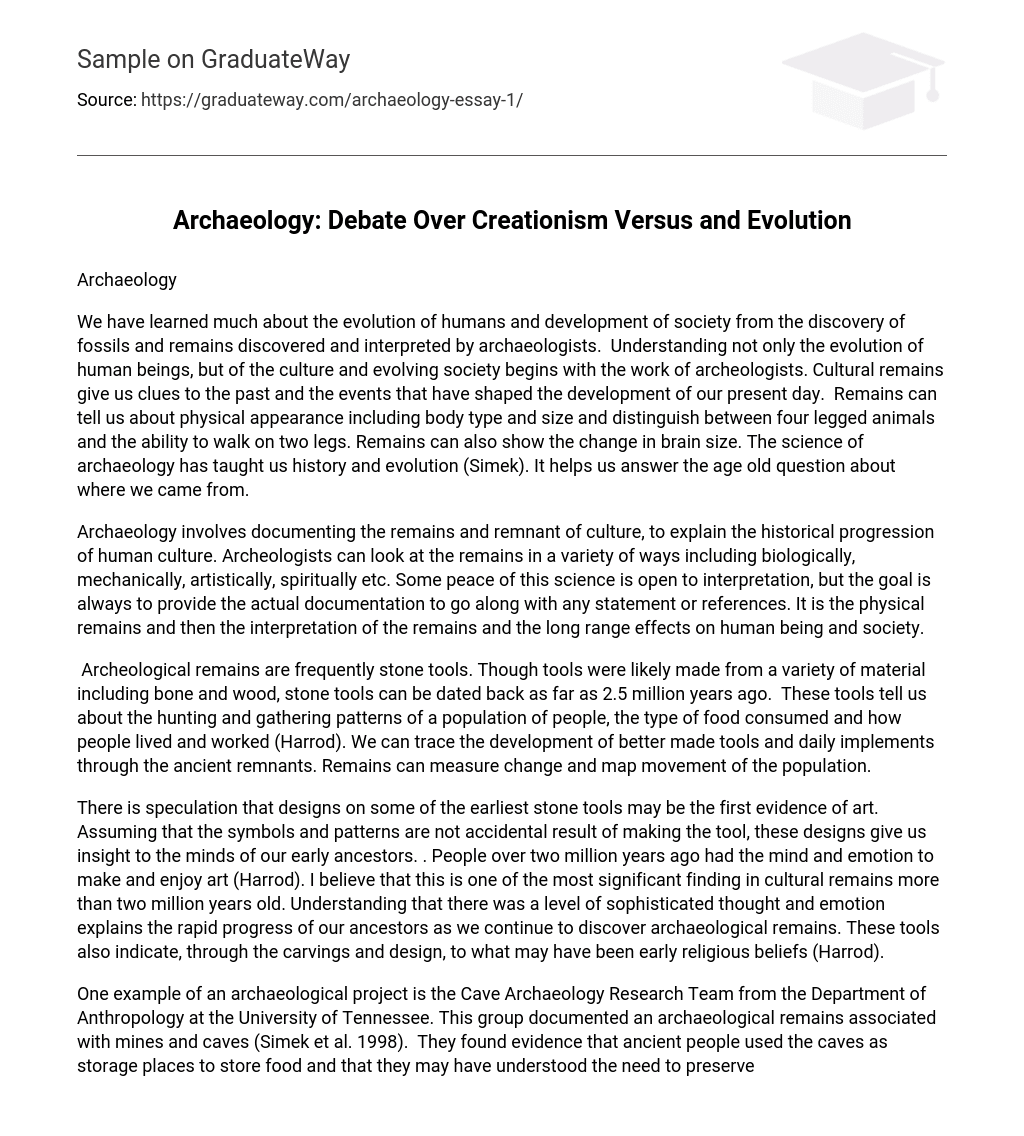Archaeology
We have learned much about the evolution of humans and development of society from the discovery of fossils and remains discovered and interpreted by archaeologists. Understanding not only the evolution of human beings, but of the culture and evolving society begins with the work of archeologists. Cultural remains give us clues to the past and the events that have shaped the development of our present day. Remains can tell us about physical appearance including body type and size and distinguish between four legged animals and the ability to walk on two legs. Remains can also show the change in brain size. The science of archaeology has taught us history and evolution (Simek). It helps us answer the age old question about where we came from.
Archaeology involves documenting the remains and remnant of culture, to explain the historical progression of human culture. Archeologists can look at the remains in a variety of ways including biologically, mechanically, artistically, spiritually etc. Some peace of this science is open to interpretation, but the goal is always to provide the actual documentation to go along with any statement or references. It is the physical remains and then the interpretation of the remains and the long range effects on human being and society.
Archeological remains are frequently stone tools. Though tools were likely made from a variety of material including bone and wood, stone tools can be dated back as far as 2.5 million years ago. These tools tell us about the hunting and gathering patterns of a population of people, the type of food consumed and how people lived and worked (Harrod). We can trace the development of better made tools and daily implements through the ancient remnants. Remains can measure change and map movement of the population.
There is speculation that designs on some of the earliest stone tools may be the first evidence of art. Assuming that the symbols and patterns are not accidental result of making the tool, these designs give us insight to the minds of our early ancestors. . People over two million years ago had the mind and emotion to make and enjoy art (Harrod). I believe that this is one of the most significant finding in cultural remains more than two million years old. Understanding that there was a level of sophisticated thought and emotion explains the rapid progress of our ancestors as we continue to discover archaeological remains. These tools also indicate, through the carvings and design, to what may have been early religious beliefs (Harrod).
One example of an archaeological project is the Cave Archaeology Research Team from the Department of Anthropology at the University of Tennessee. This group documented an archaeological remains associated with mines and caves (Simek et al. 1998). They found evidence that ancient people used the caves as storage places to store food and that they may have understood the need to preserve food from heat or cold. The caves also served as possible retreats from other warring tribes, enabling the people to position themselves for the best defense. Thee caves were also used for what spiritual practices. The group found that small rocks were used for flints and heads for arrows and spears which could be used for weapons to hunt and defend themselves. With each layer of excavation, more was discovered about the early people existence (Simek et al 1998).
Time has proven that many of the processes used by people of the past have lasting effects. From examining the past, we can learn from our predecessor’s mistakes and the devastating effects of their lifestyle. We know now how to prevent and treat health issues and we understand the need for sanitary practices, clean water and cooked food. We understand that some of our ancestors were likely obliterated as a result of plagues and health problems now easily preventable. Perhaps one of the least known facts is a case where an area of huge pollutants and chemical waste has resulted in long term problems. For example, an archeological site in ancient Rome showed evidence that industrial pollution. Other research people in Europe and the Middle East between the first century BC and the second century AD were blighted, by high levels of pollution and contamination. Researchers say the pollution was actually worse that during the 19th century Industrial Revolution (Keys, 2003).
An ongoing issue for many people is the debate over creationism versus and evolution. Even archaeology doesn’t have an easy answer to the question. While remains of past cultures fascinate and interests people, polls indicate that about 40% of people reject the notion of evolution. Even with the apparent evidence of archeological digs, many people are question the link between the two sets of beliefs, or two very different explanations as to the original question, “where do we come from”. This is an issue that simply cannot be answered easily and may be beyond the scope of archaeology.
References
Harrod, J. (1992). Two Million Years Ago: The Origins of Art and Symbol. Continuum 2,1:4-29. http://www.originsnet.org/publications.html
Keys, D. (2003, December). How Rome Polluted the World, American Antiquity, December 2003.
Simek, Jan The Context of Early Prehistoric Cave Art. American Antiquity, Vol 63, 1998
Spuhler, James, Anthropology, Evolution, and “Scientific Creationism”
Annual Review of Anthropology, Vol. 14, 1985





